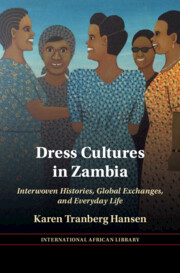Book contents
- Dress Cultures in Zambia
- The International African Library
- Dress Cultures in Zambia
- Copyright page
- Contents
- Figures
- Acknowledgements
- Prologue
- 1 Dress Practice as History
- Part I Dressing Well
- Part II Dress and Undress
- 4 Dress, Undress, Body, and Nation
- 5 Miniskirts and Dangerous Dress Practice
- 6 The Dramaturgy of Body Politics
- Part III Fashionable Transformations
- References
- Index
- Titles in the Series
5 - Miniskirts and Dangerous Dress Practice
from Part II - Dress and Undress
Published online by Cambridge University Press: 20 April 2023
- Dress Cultures in Zambia
- The International African Library
- Dress Cultures in Zambia
- Copyright page
- Contents
- Figures
- Acknowledgements
- Prologue
- 1 Dress Practice as History
- Part I Dressing Well
- Part II Dress and Undress
- 4 Dress, Undress, Body, and Nation
- 5 Miniskirts and Dangerous Dress Practice
- 6 The Dramaturgy of Body Politics
- Part III Fashionable Transformations
- References
- Index
- Titles in the Series
Summary
Widespread cultural sensibilities about gender, sexuality, age, and status converge on the dressed body, weighing down on women’s bodies much more heavily than on men’s. Reactions to the miniskirt go to the heart of normative cultural assumptions about the hierarchical nature of gender relations in most of Zambia’s ethnic groups and across the country’s class spectrum. When miniskirts first became fashionable in the late 1960s and early 1970s, they fueled discussions about women’s proper place in the new nation; ‘foreign’ influences were blamed for independent women’s lack of morality. In the 1990s when the miniskirt returned, the debate developed a sharper and violent edge, mobilising ideas associating sexuality with women’s dress practice. Stripping incidents of women wearing short skirts and tight clothing occurred in downtown space again and again during the 2000s. Recently they have been followed by protests that are turning violence against women into a general social issue.
- Type
- Chapter
- Information
- Dress Cultures in ZambiaInterwoven Histories, Global Exchanges, and Everyday Life, pp. 79 - 98Publisher: Cambridge University PressPrint publication year: 2023



